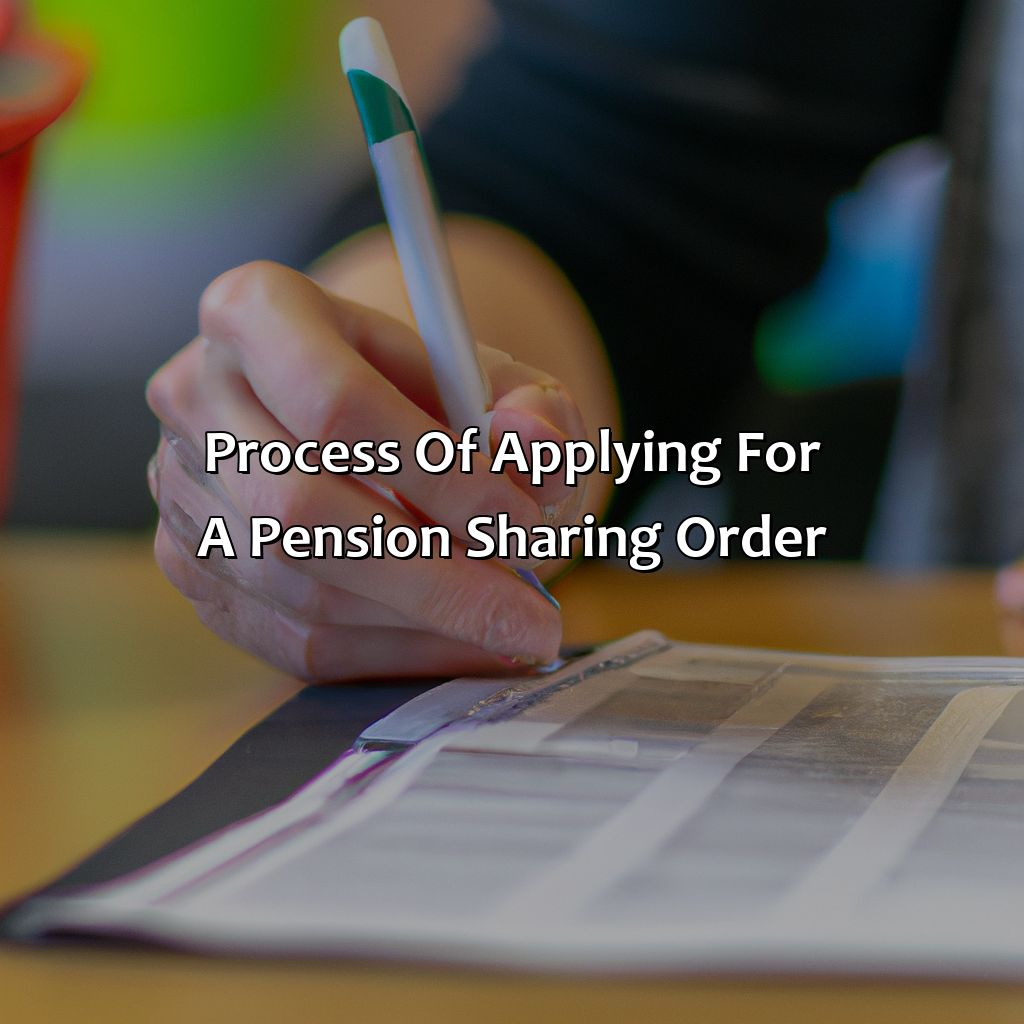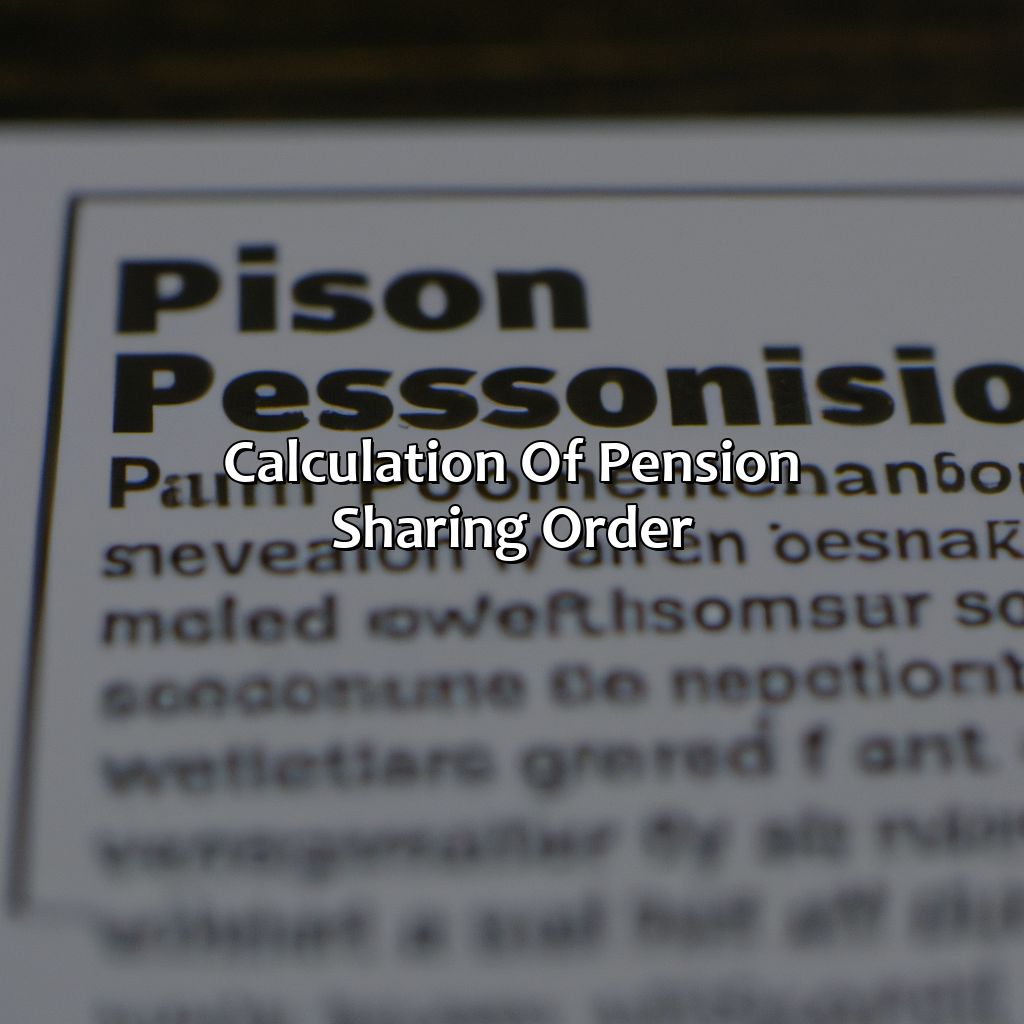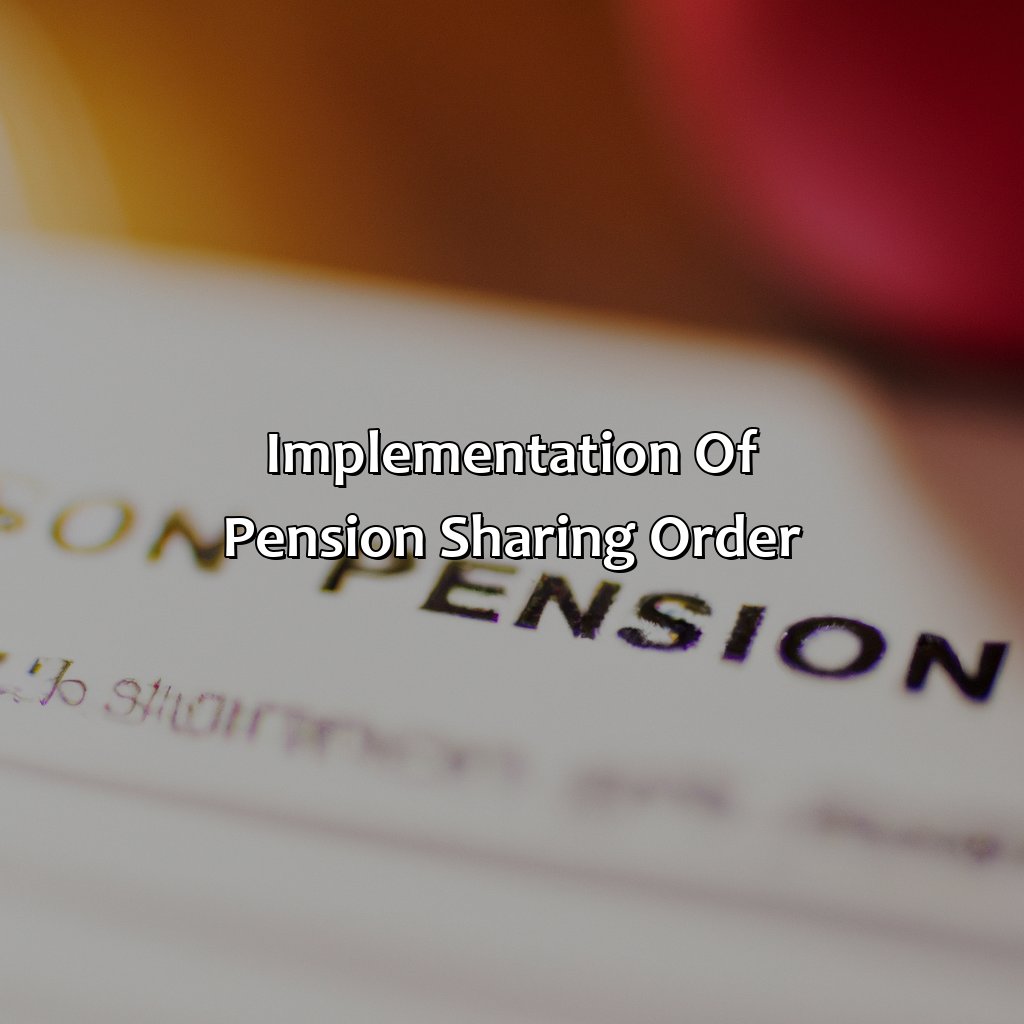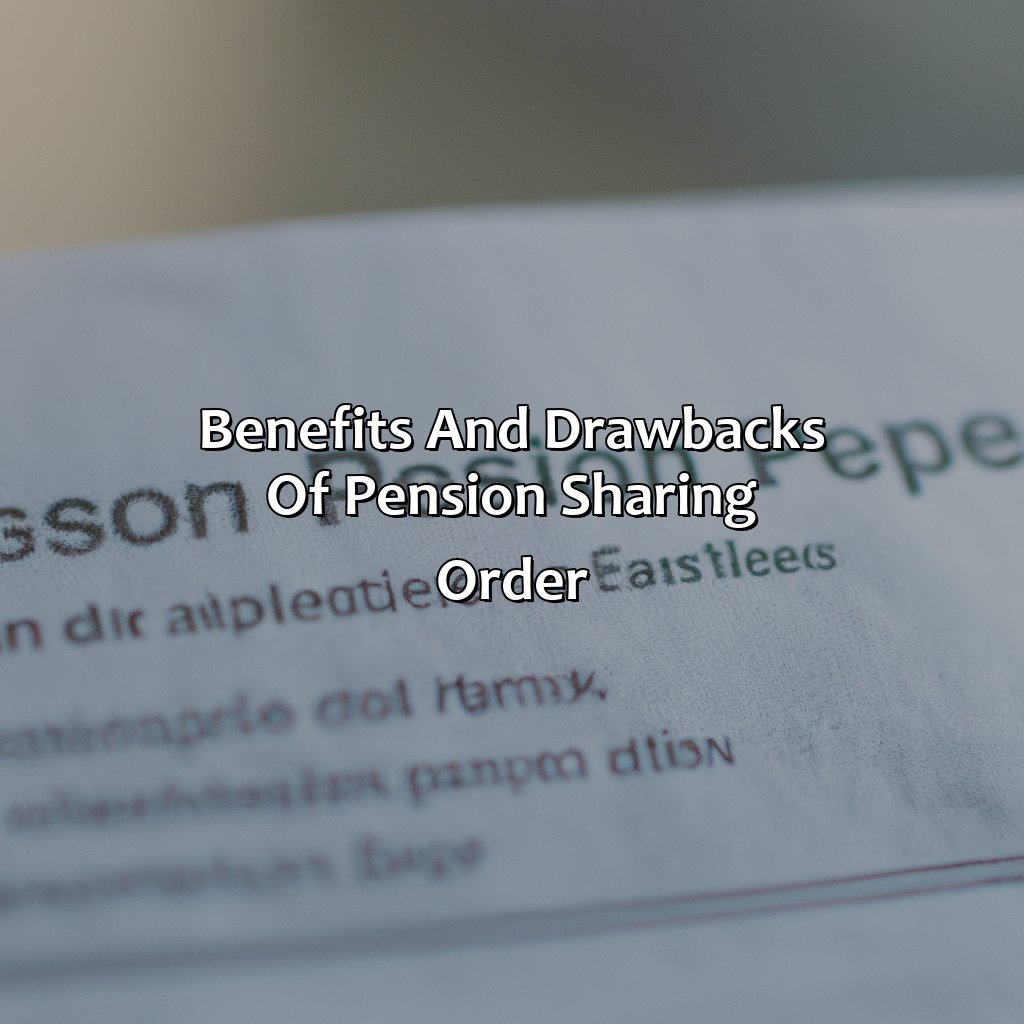What Is A Pension Sharing Order?
Key Takeaway:
- A Pension Sharing Order is a court order made during divorce or dissolution of a civil partnership that requires a pension scheme to divide the pension benefits between the parties.
- Either party to a divorce or dissolution of a civil partnership can apply for a Pension Sharing Order. The application must be made to the court and include details of the pension scheme to be shared.
- The process of applying for a Pension Sharing Order involves obtaining a court order or agreement, determining the value of the pension benefits to be shared, and implementing the sharing by transferring the benefits to the recipient’s pension scheme or creating a new pension scheme for them.
- The calculation of a Pension Sharing Order is based on the cash equivalent transfer value (CETV) of the pension benefits to be shared at the time of the order.
- Implementing a Pension Sharing Order involves notifying the pension scheme administrator, ensuring the recipient receives their share of the benefits, and monitoring any tax implications of the sharing.
- The benefits of Pension Sharing Orders include ensuring both parties have financial security in retirement and providing a fair and equitable division of pension benefits. The drawbacks may include additional costs and complexities involved in implementing the sharing.
Are you looking for more information about pension sharing orders? You’ve come to the right place. In this article, we’ll discuss the basics of a pension sharing order and why they can be beneficial. Don’t worry if you’re new to this; we’ll help you understand all the details.
Definition of Pension Sharing Order
A pension sharing order is a legal document that allows the division of pensions upon divorce. This order mandates the pension scheme administrator to split the pension into two parts, as agreed by divorcing parties. The divided pensions result in separate pension policies that are then owned individually by each party.
The distribution of pensions is based upon the value of the pension at the time of the divorce, rather than at the point of retirement. Thus, the pension sharing order allows for a fair distribution of the pension value based on the contributions made during the marriage. The order can be issued during or after a divorce, and both parties have to agree to its terms. Learn more about IRAs that provide pensions for employees.
It is essential to note that the pension sharing order is not applicable to all types of pensions. Only defined contribution and defined benefit schemes are eligible, and state pensions cannot be split. It is crucial for both parties to take independent financial advice before agreeing to any pension sharing order. If you are wondering about your pension information, you can check out this helpful guide on how to find it.
In the past, ex-spouses had to rely on a pension attachment order for the distribution of pensions. This order was not entirely effective, as it relied on the pension holder to retire before the pension could be received. Additionally, this order did not result in a clean break, meaning the financial affairs between the two parties were not entirely concluded. The introduction of pension sharing orders has resolved these issues, resulting in a more simple and clear settlement upon divorce.

Image credits: retiregenz.com by Joel Duncun
Who Can Apply for a Pension Sharing Order
Pension Sharing Order: Eligibility Criteria
To apply for a Pension Sharing Order, one needs to be either married or in a civil partnership. The applicant could be either party in the relationship or an agent on behalf of a party, such as a legal representative. The order can apply to private pensions, workplace pensions, and State Pension. The applicant must obtain a court order to enforce the order.
If you’re wondering who manages pension funds, it’s important to know that Pension Sharing Orders are managed by the court system, where the applicant must obtain a court order to enforce the order.
It is imperative to note that the order can also be requested as part of the divorce or dissolution settlement. Moreover, the applicant needs to consider the financial consequences of the order, including the potential tax implications and any fees charged by the pension provider.
Pro Tip: Seek legal advice and financial consultation before applying for a Pension Sharing Order to understand the financial implications.

Image credits: retiregenz.com by Yuval Washington
Process of Applying for a Pension Sharing Order
Pension Sharing Order or PSO is a legal proceeding used to divide retirement benefits between divorcing couples. Here is a step-by-step guide on how to apply for a PSO:
- Start by obtaining a valuation of your pension scheme from your pension provider.
- Seek legal advice and inform your solicitor of your intention to apply for a PSO.
- Fill out the necessary forms, including the PSO application form and the court fee remission application if applicable.
- Send the completed forms to the court for processing, along with the necessary court fees.
- Attend the court hearing, where the judge will determine the percentage of benefits each spouse will receive.
- Once the PSO has been issued, notify your pension provider, who will make the appropriate adjustments to your retirement benefits.
It’s important to note that there may be deadlines for applying for a PSO and that legal costs can vary. Additionally, be sure to disclose all assets and financial information in the divorce proceedings to ensure a fair division of assets.
To ensure a smooth and successful PSO application, it’s recommended that couples seek legal advice and cooperate fully throughout the process. By being transparent and working together, couples can minimize stress and costs associated with the PSO application process.

Image credits: retiregenz.com by Adam Washington
Calculation of Pension Sharing Order
When it comes to dividing pension assets during a divorce, the Calculation of Pension Sharing Order is an essential step. It is the process of determining the amount of the pension that will be shared between the former spouses.
To calculate the Pension Sharing Order, the following columns need to be considered: the name of the pension provider, the percentage of the pension to be shared, the cash equivalent transfer value (CETV), and the actual amount to be transferred. For example:
| Pension Provider | % of Pension to be Shared | CETV | Actual Amount |
|---|---|---|---|
| ABC Pension Ltd. | 50% | 100,000.00 | 50,000.00 |
| XYZ Pension Fund | 25% | 80,000.00 | 20,000.00 |
It is worth noting that the Calculation of Pension Sharing Order should be done as early as possible in the divorce process. Moreover, a Pension Sharing Order can affect the receiving spouse’s entitlement to means-tested benefits, and it is always recommended that both parties seek independent financial advice to fully understand the implications of a Pension Sharing Order.
\n
Suppose you are going through a divorce and need to calculate your Pension Sharing Order. In that case, it is recommended that you gather all the necessary information, including the CETV, and consult with a financial advisor to guide you through the process. It is also essential to be aware of any tax implications and how they may affect you in the long term. Additionally, it is crucial to keep your pension provider informed of any changes to your marital status to avoid any issues in the future.

Image credits: retiregenz.com by Adam Washington
Implementation of Pension Sharing Order
A pension sharing order entails dividing a pension after divorce or dissolution of a civil partnership. With this order, each partner gets a share of the pension. It is a legal process that helps to divide the pension between the partners fairly.
A 6-Step Guide to Pension Sharing Order:
- Apply to the court for a pension sharing order
- The court then issues a notice of the proceedings to the pension provider
- The pension provider checks for any benefits payable to the other partner, and the court will then decide how to split the pension
- The pension provider will set up new benefits for the partner who is entitled to them
- The pension sharing order comes into effect when the pension provider receives the necessary documents from the court
- The pension provider then executes the order, and the pension is shared accordingly
It is essential to seek legal counsel when obtaining a pension sharing order. The court ensures that the sharing is fair, and the process involves determining the current value of the pension, the length of marriage, contributions made, and any other factors affecting the pension’s value.
If you want to understand more about how pension fund works, make sure to check out this informative article.
Example:
A couple filed for divorce after twenty years of marriage, and the pension was a significant asset in the marriage. The husband had contributed more to the pension, and the wife did not have any form of pension. The court ordered a pension sharing order, and the husband got 60% of the pension, while the wife got 40%. The pension provider executed the order to the letter, and each partner got their share of the pension.

Image credits: retiregenz.com by Adam Duncun
Benefits and Drawbacks of Pension Sharing Order
Pension sharing orders allow for the division of pension benefits between couples during a divorce or dissolution. This can offer both benefits and drawbacks, which are discussed further below.
- Provides a clean break option for couples.
- Offers flexibility in dividing pension benefits.
- Allows for fair distribution of retirement income between parties.
- Eliminates the need for one party to become reliant on the other’s pension income.
- May result in a reduction of pension benefits for both parties due to administrative fees.
- Benefit payments are directly impacted by the pension fund’s performance, which can lead to uncertainty.
- May require costly legal fees for couples to reach an agreement.
- Financial planning for retirement may become more complicated due to the division of assets.
Unique details to consider include the fact that pension sharing orders do not always lead to an equal distribution of benefits due to factors such as age, length of marriage, and individual contributions made to pensions.
Pro Tip: Consider consulting a financial advisor or pension specialist to fully understand the potential impact of a pension sharing order on your financial situation.

Image credits: retiregenz.com by Harry Arnold
Five Facts About Pension Sharing Orders:
A pension sharing order is a legal mechanism where a pension is divided between a divorcing couple. (Source: Gov.uk)
Pension sharing orders can only happen on divorce or dissolution of a civil partnership. (Source: Citizens Advice)
Pension sharing orders can give one partner a share of the other’s pension and will be done on a percentage basis. (Source: Money Advice Service)
Pension sharing orders can only be issued in a Financial Order during divorce proceedings. (Source: Royal London)
Pension sharing orders can have significant financial implications for both parties, and it’s advisable to seek legal and financial advice. (Source: Which?)
FAQs about What Is A Pension Sharing Order?
What is a pension sharing order?
A pension sharing order is a court order that divides a person’s pension during a divorce settlement. It allows for a portion of one partner’s pension to be transferred to the other partner.
Who can get a pension sharing order?
Anyone who is going through a divorce or civil partnership dissolution can apply for a pension sharing order. It is only available to couples who were married or in a civil partnership.
How is the pension divided under a pension sharing order?
The pension is divided based on a percentage agreed upon by the couple or decided by the court. The percentage is then applied to the value of the pension at the time of the divorce or dissolution.
What are the benefits of a pension sharing order?
A pension sharing order provides both partners with a fair share of the pension. It can also provide financial stability for both partners, particularly if one partner has not worked during the marriage.
Are there any drawbacks to a pension sharing order?
The main disadvantage of a pension sharing order is that it reduces the overall value of the pension for both partners.
What happens to the pension sharing order if one partner dies?
If the partner who received the shared pension dies before reaching retirement age, the portion of the pension transferred to them will be passed on as part of their estate. If they die after reaching retirement age, they will continue to receive the shared pension until their death.
 Checkout this IRS Loophole
Checkout this IRS Loophole 
